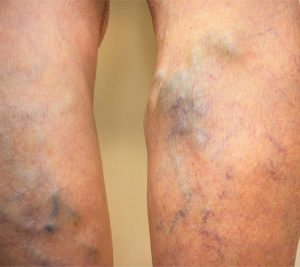By Zulay Zayas, ARNP
 Varicose veins and spider veins are swollen, twisted veins that usually appear on the legs. Women are more likely to have varicose veins and spider veins. Pregnancy, older age, and obesity can increase your risk of varicose veins and spider veins. Varicose veins and spider veins are often painless and do not usually cause health problems.
Varicose veins and spider veins are swollen, twisted veins that usually appear on the legs. Women are more likely to have varicose veins and spider veins. Pregnancy, older age, and obesity can increase your risk of varicose veins and spider veins. Varicose veins and spider veins are often painless and do not usually cause health problems.
Many of us will eventually encounter vein health issues. It’s usually hereditary, so if your parents or grandparents have or had spider or varicose veins, you are more likely to develop them as well. If you become pregnant or have a job or lifestyle that requires standing for long periods of time, this may make them worse, or increase the probability of getting them.
Spider veins
Spider veins (telangiectasia) are damaged, visible blood vessels just beneath your skin’s surface. They typically look red, blue or purple. They may appear in clusters that resemble spider webs or tree branches. Spider veins can form anywhere, but they usually develop in your legs or face.
Varicose veins
Varicose veins are deeper. When they become noticeable, they begin to pop out — giving the vein a 3D appearance. These veins supply blood to deep muscle tissue, so they’re bigger. That means when they become visible, they’re more obvious.
COMMON RISK FACTORS FOR SPIDER AND VARICOSE VEINS
There are a number of factors that put people at a greater risk of developing spider and varicose veins.
Some of these include:
• Obesity – extra weight puts additional pressure on the veins.
• Age – though spider veins don’t exist only in older people, the disease progresses with time. This is due to the fact that there is greater wear and tear on vein valves over time. This makes it more difficult for blood to flow properly, and can result in blood pooling.
• Pregnancy – in order to support a baby during pregnancy, blood volume nearly doubles, which leads to enlarged veins and potentially spider veins.
• Genetics – the chances of developing spider veins increases if others in the family suffer from them.
• Sedentary lifestyle – sitting or standing for extended periods of time restricts blood flow and can lead to blood pooling.
• Gender – due to hormonal changes women often experience during pregnancy and menopause, spider veins are more likely to occur in women.
• Hormonal changes – these occur during, pregnancy, and menopause. Taking birth control pills and other medicines containing estrogen progesterone also may contribute to the forming of varicose or spider veins.
• Sun exposure – this can cause spider veins on the cheeks or nose of a fair-skinned person.1
Diagnosis
Diagnosis of spider and varicose veins happens with a simple physical examination by a vein specialist. Because these veins are visible at the surface of your skin, they can simply be diagnosed by a vein specialist during a physical exam. As mentioned above, spider veins can appear anywhere on the legs, the face, and the chest. They are purple, blue, pink or red and typically resemble a spider web and can be flat or slightly raised to the touch. Varicose veins are 3D and primarily on the legs.
Treatment
The good news is that we don’t have to live with these visible and unsightly veins. There are a number of treatment options available for those who’d like to look younger and have healthier looking skin.
Zulay Zayas, is an advanced registered nurse practitioner (ANRP) with many years of experience in the cardiac and endovascular field of study, who currently works in Naples, FL. at the Naples Cardiac & Endovascular Center.
Zulay began to work at the Naples Cardiac & Endovascular Center as an advanced registered nurse practitioner. She is responsible for venous pre-op evaluations and post-op follow-ups, and treats patients who need sclerotherapy and transcutaneous laser treatments for spider veins.
For an appointment with Zulay and the highly trained, professional team at Naples Cardiac & Endovascular Center, visit our website at www.heartvein.com or call 239.300.0586.
Naples Cardiac and Endovascular Center
1168 Goodlette N., Naples, FL 34102
239-300-0586 | www.heartvein.com
Reference:
1. Spider veins – symptoms, causes & treatments (2022) Vein Clinics of America. Available at: https://www.veinclinics.com/conditions/spider-veins/.








